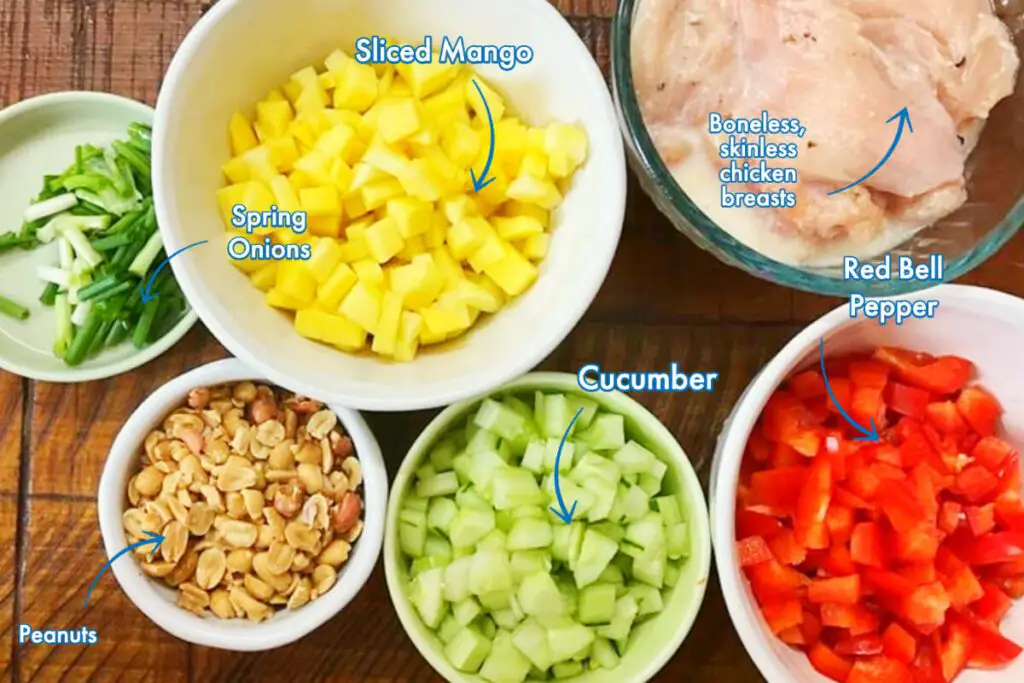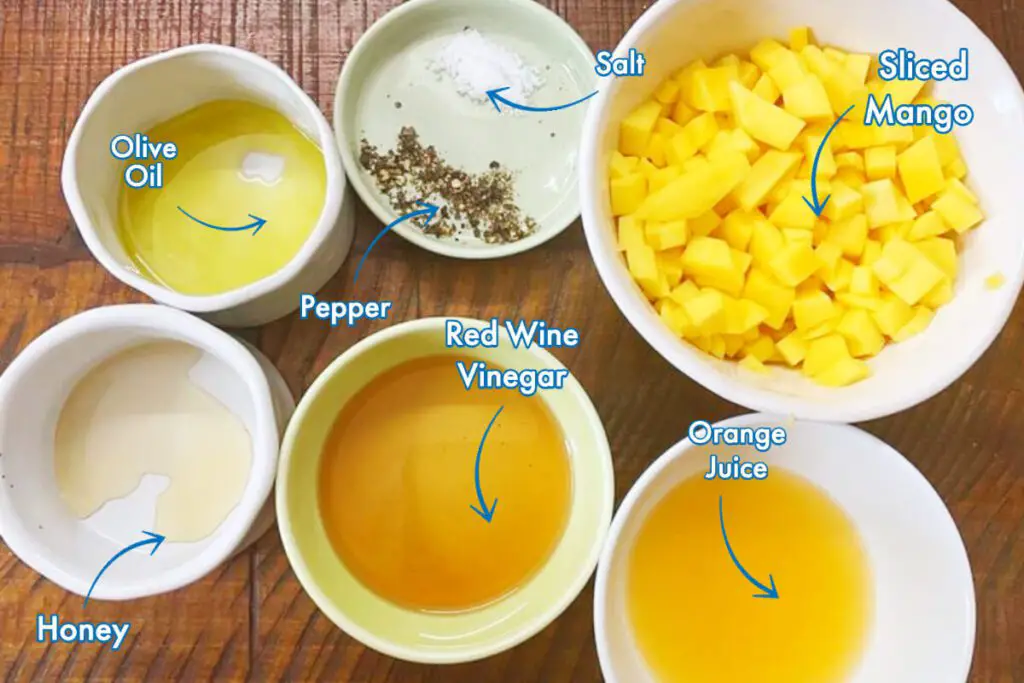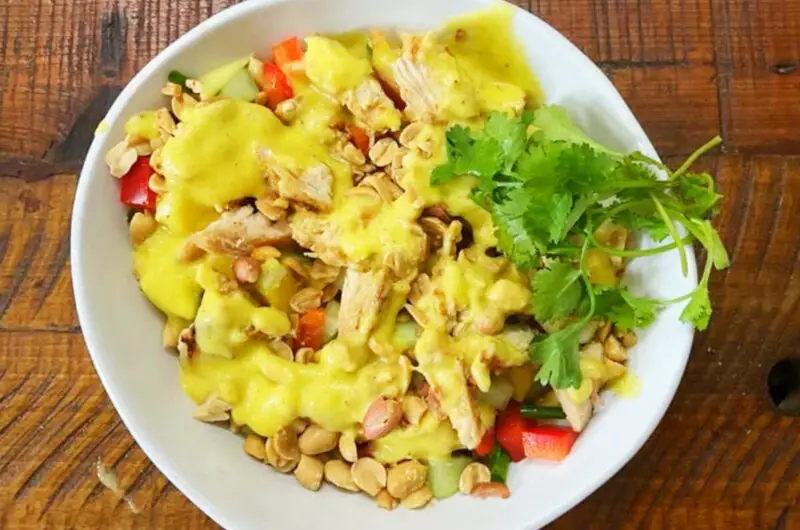Mango is one of my favorite tropical fruits. I have been lucky enough to live in a part of the world with fresh mangos.
Indulge in the vibrant flavors of an Asian-inspired Chicken Mango Salad with a unique twist. This delightful recipe features mango in the salad and tangy mango dressing, adding tropical sweetness. To enhance the authentic Asian experience, we’ve included peanuts for a delightful crunch and to infuse the dish with authentic Asian flavors. Discover why mangoes are such great fruits and pair perfectly with this salad.
Table of Contents
- Mango: The Tropical Delight With A Burst Of Sweetness Perfect For A Chicken Salad
- Chicken Mango Salad & Mango Dressing Recipe
- Chicken Mango Salad & Mango Dressing Recipe
Mango: The Tropical Delight With A Burst Of Sweetness Perfect For A Chicken Salad
The mango, a popular tropical fruit, is renowned for its delicious flavor and versatility in sweet and savory dishes. With its origins in India, the mango has become an iconic fruit worldwide and holds the distinction of being the national fruit of India.

The cultivation of mangoes extends to various regions, including parts of Asia, Mexico, South America, and central Africa. With over 500 named varieties, mangoes offer a wide range of colors, textures, sizes, and flavors, making them a delightful treat for fruit lovers.
Characteristics Of Mango Explored
The mango tree, a member of the cashew family, can produce an impressive quantity of fruits per harvest, often exceeding 100. Some mango varieties even bear fruit twice a year and have a lifespan of up to 300 years.
Mangoes come in various colors, including green, yellow, orange, and red, with different hues and combinations indicating their ripeness. The flesh of a mango is typically yellow or orange, surrounding a flat, hard pit. The fruit is peeled and cut away from the pit before consumption.
Culinary Uses Of Mango
Mangoes offer a wide range of culinary possibilities. When ripe, they have a sweet, tropical flavor resembling a delightful peach and pineapple blend.
The texture can vary, but commercially grown mangoes tend to strike a balance between sweet and tart, with a texture similar to that of a ripe peach. Ripe mangoes can be enjoyed fresh, sliced, or cubed, enhancing the flavor of fruit salads, smoothies, and desserts.
Mangoes can also be incorporated into savory dishes, adding a unique twist to various recipes. Their natural sweetness complements the flavors of salads, curries, salsas, and chutneys. Unripe mangoes, with their crunchy and tart taste, are particularly popular in some Asian salads, especially in Vietnam and Thailand.
Cooking With Mango
Before using a mango, it should be washed, dried, and peeled. The peel can be removed using a peeler or a sharp paring knife.
To extract the fruit from the pit, the mango can be sliced down the length of the fruit, avoiding the complex, stringy parts close to the pit. The process is repeated on the other side, cutting away sections until all the edible fruit is separated.
This would be similar to cutting a fresh pineapple, i.e., taking off the outside and cutting the pineapple from the core or center.
Alternatively, the mango can be cubed by cutting sections of the fruit along the pit, scoring the flesh into squares, and then turning the mango inside out to push the cubes of fruit apart.
Taste Profile Of Mango Explored
The taste of a ripe mango is a delightful experience. That is why a mango continues to be a favorite fruit for so many people.
The mango’s sweet, tropical flavor resembles a combination of peach and pineapple and evokes a sense of indulgence. However, it’s important to note that different mango varieties offer variations in sweetness and texture.
Fresh mangoes try to balance sweet and tart flavors, appealing to a wide range of palates. On the other hand, unripe mangoes offer a crunchy and tart taste that adds a refreshing twist to many salads and savory dishes.
I lived in Thailand and had a green mango tree in my front yard. We would pick the mangoes and use them only for a Thai mango salad. The taste of the green mange was very tart,
My other neighbor had another mango tree: the yellow mango, which we would eat with sticky rice and coconut milk or even on top of ice cream.
Buying And Storing Tips For Mango
Mangoes are widely available in supermarkets throughout the year, with greater availability during the late spring and early summer. When purchasing mangoes, selecting fruit that feels heavy and is free of cuts or bruises is advisable.
Ripe mangoes emit a tropical fruity aroma and give slightly when gently pressed. The color of the mango skin can vary depending on the variety, ranging from a combination of red, orange, and green shades to golden yellow or green when ripe.
To ripen an unripe mango, it can be kept at room temperature for several days until it reaches the desired level of ripeness. Placing the mango in a brown paper bag can accelerate the ripening process.
Once ripe, a whole mango can be stored in the refrigerator for a few days before use.
If you have a ripe mango and want to store it for later use, it is best to cut it and store it in an airtight container in the refrigerator. This will help preserve its freshness and flavor for a few days.
Alternatively, you can freeze the mango by cutting it into cubes and placing them in a sealed bag. Frozen mango can last up to six months if kept adequately frozen.
Mango Varieties Explained
Like many other tropical fruits, there are many varieties of mangoes. Even when traveling within Southeast Asia, you will find that the mangoes’ varieties, taste, and consistency can change.
That is because mangoes come in various flavors, textures, and colors. With over 500 named varieties, a mango suits every preference. Some of the famous mango varieties include
- Tommy Atkins – This variety is the most widely sold in the U.S. It has a mildly sweet taste, firm orange flesh, and a reddish peel with green and yellow undertones.
- Honey – Honey mangoes are smaller and flatter, resembling a bean in shape. They have bright yellow skin and sweet, juicy flesh. Honey mangoes have a smaller pit, providing a higher flesh-to-pit ratio.
- Alphonso – Known as the “King of Mangoes,” Alphonso mangoes have a rich, creamy texture and a sweet, aromatic flavor. They are highly sought after for their superior taste and are often used in desserts and beverages.
- Kensington Pride – Also known as Bowen mango, this Australian variety is renowned for its sweet and tangy flavor. It has vibrant orange skin and juicy flesh.
- Keitt – Keitt mangoes are large, green-skinned mangoes with a sweet and mild flavor. They have a firm texture and are famous for both eating fresh and used in cooking.
- Kent – Kent mangoes have sweet and juicy flesh with a rich flavor. They have greenish-yellow skin with a red blush when ripe.
These are just a few examples of the many mango varieties available. Each variety offers unique tastes and characteristics, making the mango fruit of endless exploration and culinary possibilities.
The mango is a tropical delight that has captured the hearts and palates of people worldwide. It is a beloved fruit with its vibrant colors, luscious sweetness, and versatility in sweet and savory dishes.
There is no wonder why we love this mango chicken salad. It has a delectable taste and a perfect combination between sweet and savory.
Chicken Mango Salad & Mango Dressing Recipe
This Chicken Mango Salad is accompanied by a delightful Mango dressing that enhances its sweet flavors. Here are some essential tips to keep in mind when preparing this salad:


- Fresh Ingredients – The foundation of any great salad lies in using fresh ingredients. Ensure you opt for the freshest vegetables and fruits, significantly enhancing your salad’s overall taste and quality.
- Pound the Chicken to Tenderize – It is crucial to tenderize the chicken before cooking. Use a meat tenderizer tool to pound boneless, skinless chicken breasts, making them thinner. This technique allows the seasonings to penetrate the meat, promotes even cooking, and reduces the risk of dryness.
- Cooking the Chicken – You can fry the chicken in a pan or grill it on a barbecue. Grilling is often preferred as it tends to be more convenient. Season the chicken with salt and pepper; add a touch of butter for extra flavor if frying.
- Blend the Dressing – The most straightforward way to prepare the dressing is by blending mango pieces, honey, freshly squeezed orange juice, vinegar, oil, salt, and pepper in a blender. Blend until smooth. If the dressing appears too thick due to the type of mango used, adjust the consistency by adding more orange juice.
- Freshly Squeezed Orange Juice – Opt for freshly squeezed orange juice whenever possible. While it may take a bit more time and effort, the taste far surpasses store-bought varieties and enhances the overall flavor of the dressing. We use our leftover fresh orange juice to marinate our chicken breasts.
- Optional Peanuts – The combination of peanuts and mangoes is magical, often seen in many Asian dishes. Adding peanuts to the salad provides an extra crunch and protein. Feel free to include them if desired.
- Vegan/Vegetarian Variation – For those following a vegan or vegetarian diet, you can omit the chicken and substitute it with fried tofu. Additionally, including peanuts will provide extra protein and crunch to the salad, resulting in a beautiful and flavorful alternative. You can salt and pepper the tofu and then fry it also with some salt and pepper to taste.
When using the mango puree in the dressing, you’ll require less oil than traditional salad dressings while still enjoying its delicious taste.
Mango Cheeks Vs. Mango Flesh
In the recipe, we distinguish between mango cheeks and mango flesh. Typically, the cheeks refer to the outer portions of the mango that receive more sunlight, while the flesh refers to the inner part. However, when preparing this salad, it’s essential to consider the texture and condition of the mango.
For the salad, select mango cheeks that are slightly firmer and not overly ripe. These firmer portions are ideal for adding a refreshing crunch to the salad. On the other hand, if you come across a mango that has become squashed or crushed, and the texture resembles flesh, it is best to use that for the dressing.
Don’t hesitate to remove the mango flesh from the core, as it ensures you utilize as much fruit as possible in your dish. By discerning the texture and utilizing the different parts of the mango accordingly, you can create a well-balanced salad with a delightful combination of textures and flavors.
This Chicken Mango Salad combines sweet and savory flavors with its delightful Mango dressing. By utilizing fresh ingredients, tenderizing the chicken, and blending the dressing to perfection, you can create a salad that is not only delicious but also versatile enough to accommodate vegan and vegetarian preferences.



